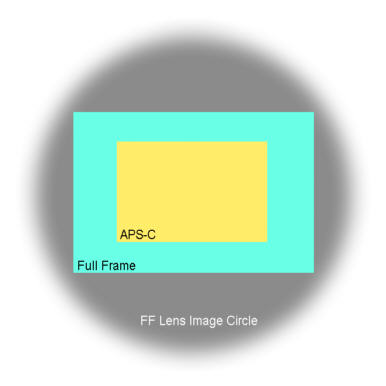
The question here is whether the image quality of a full frame sensor will be higher than that of an APS-C sensor, given real lenses which have imperfections. First we have to look at what the image produced by a lens actually looks like. For a full frame 35mm lens th eimage is actually a circle of at least 43mm diameter. It's sharp in the center and tends to "fuzz out" at the edges. Making the image circle larger cost money and makes the lens larger and more complex, so manufacturers tend to make the image circle just large enough for a 35mm frame (shown in light blue in the diagram below). Sometimes this means image quality at the corners isn't as good as it might be. A more expensive lens might have a slightly larger image circle and better quality at the position sof the 35mm frame corners.
APS-C sensors are quite a bit smaller than full frame (15x22.5mm vs. 24x36mm) and so only the the center (or "sweet spot") of the image circle. So in many cases, the image quaity at the position corresponding to the corner of an APS-C sensor is higher than that corresponding to the corner of a full frame 35mm sensor.

| Format | Corner to Center | Left/Right Edge to Center | Top/Bottom to Center |
| Full Frame 36mm x 24mm |
21.5mm | 18mm | 12mm |
| APS-C 22.5mm x 15mm |
13.5mm | 11.25mm | 7.5mm |
Aberrations (inperfections) in images usually vary with the distance from the center of the frame, in the manner shown in the table below for simple lenses.
| Varies as | FF:APS-C | |
| Spherical Aberration | - | 1 |
| Astigmatism | h2 | 2.6 |
| Coma | h | 1.6 |
| Field Curvature | h2 | 2.6 |
| Distortion | h3 | 4.1 |
| Chromatic Aberration | h | 1.6 |
This table shows how the most common aberrations vary with off axis distance (h) and the resulting difference in aberration strength between Full Frame and APS-C. Of course this is for a simple lens. Modern photographic optics are complex and the designers go to great pains to minimize all aberrations. However it does show that aberrations may go up faster with distance than a linear relationship would predict. This means that although FF is 1.6x larger than APS-C, aberrations may be more than 1.6x greater at similar field positions (top/edge/corner).
Of course if a lens were perfectly corrected for full frame then 1.6x (or 2.6x or 4.1x) no aberration = no aberration, but there are no perfect lenses! Below is an MTF plot for a real lens (The EF 28-70/2.8-4L USM at 28mm) taken from the Canon publication "Lens Work".
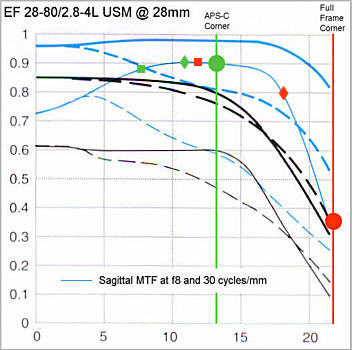
This is a rather complex plot, showing MTF as a function of distance from the center of the frame under various conditions. However let's just look at the thinner solid blue line for now. This represents the Sagittal MTF (MTF for lines pointing towards the center of the frame) at f8 for a spatial frequency of 30 cycles/mm. If this doesn't mean much to you, just think of it as a plot of sharpness vs. distance from the center of the frame and you won't be too far wrong.
The green line is the distance of the corner of an APS-C frame from the center (13.5mm) and the red line is the distance of the corner of a full 35mm frame from the center (21.5mm). You can see that for an APS-C frame corner the MTF is about 0.9 (green dot), while for a 35mm full frame it's about 0.35. If we look at the left/right frame edge we can see that for APS-C we have 0.9 (green diamond) and for full frame 35mm we have 0.8 (red diamond). If we look at the top and bottom edges, the MTF for the APS-C frame is about 0.88 and for the full 35mm frame it's 0.9.
The other lines on the plot are for different conditions (f2.8, 10 cycles/mm, tangential MTF), but it's clear that they all show similar behavior insofar as MTF (sharpness/contrast) is a function of off-axis distance and MTF tends to be (though isn't always) lower the further away from the center you go.
Things often look better at longer focal lengths though. Aberrations are a little easier to correct with telephotos than with wideangles.
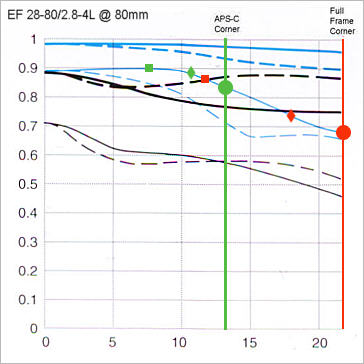
Another image aberration which depends on off axis distance is vignetting. Vignetting comes from two sources. One is the so called "Cos4Theta" falloff which is an intrinsic property of the lens optics. It's the line marked ("theoretical limit") on the plot below and it's the lowest value that vignetting can take. The other source is geometric vignetting due to the way a practical lens is constructed. This type of vignetting strongly depends on aperture. The diagram below illustrates an actual case and comes from an article in "Modern Photography" from a few decades ago!
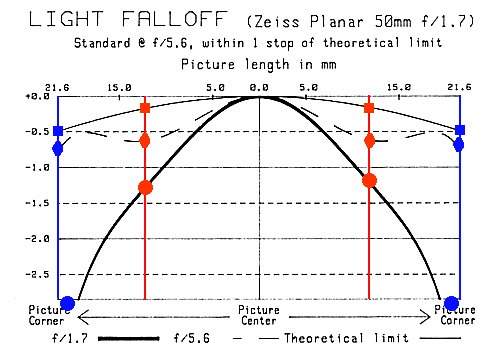
The blue lines represent the corners of a full 35mm frame, the red lines represent the corners of an APS-C frame.Wide open you can see that the corners of the full frame vignette by maybe 3 stops compared to the center (blue circle). This is a significant and quite visible amount of vignetting, but it's typical for a fast normal lens. At the corners of the APS-C frame, vignetting is only about 1.25 stops (red circle), which is a lot better. Stopped down to f5.6 the full frame vignetting drops to about 0.75 stops (blue diamond) and APS-C vignetting drops to about 0.65 stops. Stopped down further, the full frame vignetting will appraoch the theoretical cos4 limit of 0.5 stops and the APS-C vignetting will approach about 0.15 stops.
Clearly the physical size of the sensor is a factor in image quality, but equally clearly it's not the only factor. To take an absurd example, a Full Frame sensor with 100,000 (or even 1 million) pixels isn't going to better the image quality of an APS-C sensor with 10 million pixels. So pixels count too. Exactly how much they count is another complex subject, but let's just say that if you have the same number of pixels, then the larger sensor can give higher quality images, and if you have more pixels, then you're in even better shape. There could conceivably be situations when a larger sensor with somewhat fewer pixels could give better quality, but let's not get into that one!
In the article Digital Sensor Size - Why Size Matters I go into the issues of sensor size in some detail and describe how larger sensors work on the upper part of the MTF curve of a lens, while smaller sensors work on a lower part of the curve. However for the sake of argument, lets say that both Full Frame and APS-C sensors work on a part of the curve where the lens MTF is pretty high. Lets look at a 12.7 MP full frame sensor, like the on in the 5D, and an 8.2 MP sensor like the one in the 20D.
| Sensor size (mm) | Resolution (pixels) | Pixel size (microns) | Max Theor. Resolution |
Crop Factor | PPI for 12" x 18" print | |
| EOS 20D | 22.5 x15 | 3504 x 2336 | 6.4 | 78 lp/mm | 1.6x | 195 |
| EOS 5D | 35.8 x 23.9 | 4368 x 2912 | 8.2 | 61 lp/mm | 1x | 243 |
You'd think that it would be easy to compare image quality from a 5D (full frame) with a 20D (APS-C), but really it isn't. There are maybe 4 ways you could do the test.
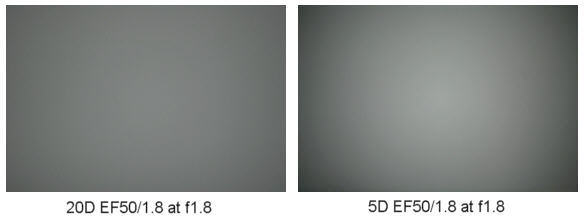
Well, the theoretical plot shown in the first part of this article seems to be born out in practice. Used wide open the full frame sensor shows significantly more vignetting as expected. This will be worse with fast, wideangle lenses and better with slower, telephoto lenses. At apertures of f8 and smaller vignetting should be slight with any decent lens.
Based on test method (4) as described above we can look at the center of images shot with a 50/1.8 lens at f8. While the 50/1.8 is a cheap lens, its performance is good, especially when stopped down to f8, so this should be representative of good lenses.
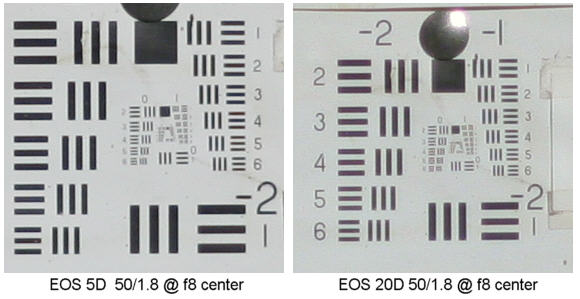
Clearly, I think, you can see that the full frame sensor of the 5D shows more detail than the APS-C sensor of the 20D.
If we now look at the edge of the frames, we see the following:
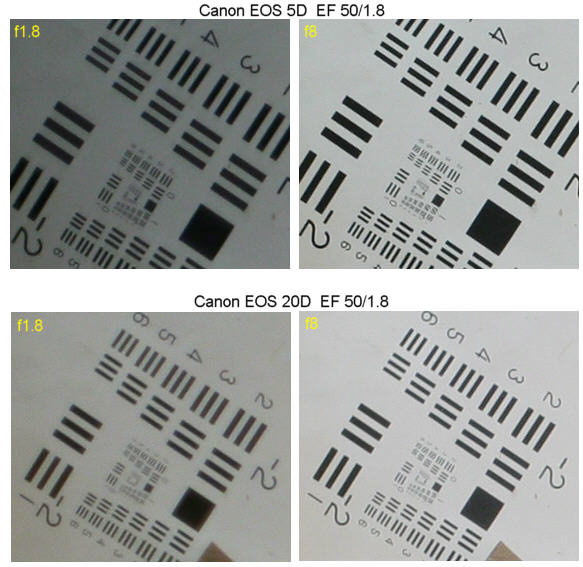
The first obvious thing is the vignetting again. The corner of the full frame shot from the 5D with the lens at f1.8 is clearly a lot darker than the center and a lot darker than the corners of the APS-C shot from the EOS 20D. In terms of resolution though, the full frame images are again superior.
Looking at a pretty average (or below) lens, here are a couple of shots from the corner of the frames using an EF 22-55/3.5-5.6 lens at 22mm and f3.5. This is s alow cost, plastic mount, lens that was originally designed for use with APS film bodies, though which does have full frame coverage.
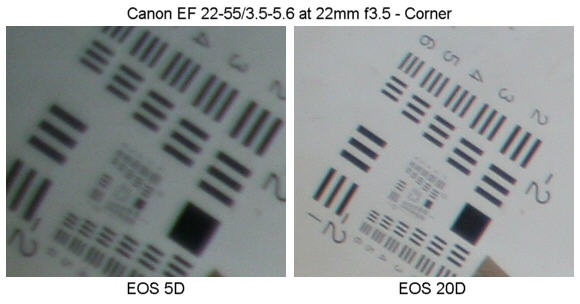
As you can see, again the full frame corners are darker due to vignetting. In this case I think the lower image quality at the corners of the full frame shot cancels out any size advantage.
Here's a series of shots under condition (3), i.e. with the same lens at the same aperture and at the same distance from the subject:
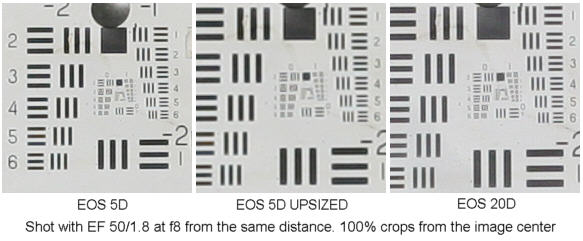
As you can see, in this case the 20D image shows more detail. This situation (same lens form same distance) is the situation that nature photographers often find themselves in. They're using their longest lens (typically a 500mm or 600mm, maybe with a multiplier on it) and they're as close to their subject as they can get. They might use a longer lens if they had one, but they don't! Under these circumstances, where you'd have to crop one or both images to the same field of view, results from an APS-C sensor with a higher pixel density (such as the EOS 20D) can give better results than thos from a full frame camera with a lower pixel density (such as the EOS 5D)
Here's a real world image comparison. shot under condition (2), i.e. a zoom lens at different focal lengths on the 5D and 20D. I tried to equalize image quality by shooting at f11 and shooting at the wide end of the 70-300/4-5.6 IS USM, where image quality is high and doesn't change a lot. In addition to comparing image quality in terms of resolution, you can compare 5D vs. 20D noise levels since these images were shot at ISO 3200. First, here's the whole image:
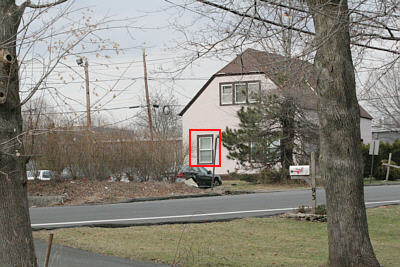
The area shown outlined in red is shown as a 100% crop in the two images below:
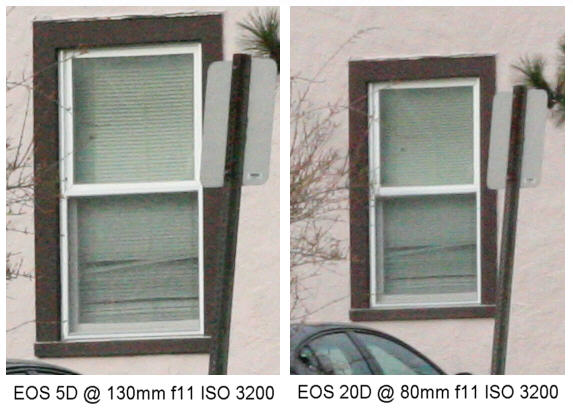
And finally here's the same two images, but with the 20D shot upsized by about 125% (using bicubic interpolation) so that the subject is the same size in both shots:
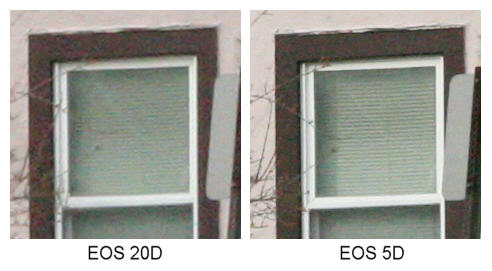
The superiority of the 5D image is clear. Now they were shot at different zoom settings, but since they were also both shot at f11 and the zoom is pretty good in this focal length range, I think what you see in the images reflects the difference between a full frame 12.7MP sensor and an 8.2MP sensor rather than any difference in lens quality.
It's a win, but not a total "slam dunk" for the full frame sensor, at least as far as the 5D vs. 20D goes. With good lenses the results from the 5D are better, though with noticably higher vignetting when lenses are used wide open. Of course you can pretty much compensate for vignetting in software, but still you lose something (it's just like having an underexposed shot). With low cost lenses shot wide open, the full frame advantage disappears, and in situations where you have your longest lens in use on an APS-C camera, switching to a lower pixel density full frame camera will yield worse results.
However there's no denying that under the right conditions, the images from a full frame camera like the EOS 5D can beat those from an APS-C camera like the EOS 2D, as the real word examples above show. Given the budget, I'd own both a 5D and a 20D and I'd use each in the situation for which it was best suited. Since I do a lot of nature work, the higher pixel density of the EOS 20D is useful for me. If I didn't shoot extreme telephotos, I'd probably pick the EOS 5D, especially if I had a good set of lenses to go with it.